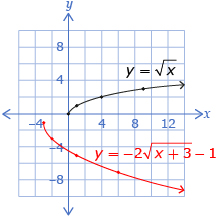Module 2: Lesson 1
Self-Check 2
- “Your Turn” on page 68
-
While this question can be solved in multiple ways, only one method is shown here. Start by identifying the transformations that take place, and then map some key points. Finally, sketch the transformed graph.
The graph of the function has been transformed from the original graph of
has been transformed from the original graph of  in the following ways:
in the following ways:
- a vertical stretch by a factor of 2 about the x-axis
- a reflection across the x-axis
- a horizontal translation 3 units to the left
- a vertical translation 1 unit down
(0, 0) → (0, 0) → (0, 0) → (−3, 0) → (−3, −1)
(1, 1) → (1, 2) → (1, −2) → (−2, −2) → (−2, −3)
(4, 2) → (4, 4) → (4, −4) → (1, −4) → (1, −5)
(9, 3) → (9, 6) → (9, −6) → (6, −6) → (6, −7)
Drawing the sketch should give the following:

- The domain is {x|x ≥ −3, x ∈ R}.
The range is {y|y ≤ −1, y ∈ R}.
The domain is really only affected by the horizontal translation, where the horizontal translation 3 to the left changes the domain from {x|x ≥ 0, x ∈ R} to {x|x ≥ −3, x ∈ R}.
The range is affected by two of the transformations. The reflection about the y-axis changes the range from {y|y ≥ 0, y ∈ R} to {y|y ≤ 0, y ∈ R}. The translation 1 unit down changes the range from {y|y ≤ 0, y ∈ R} to {y|y ≤ −1, y ∈ R}.
-
While this question can be solved in multiple ways, only one method is shown here. Start by identifying the transformations that take place, and then map some key points. Finally, sketch the transformed graph.
© 2012 Alberta Education